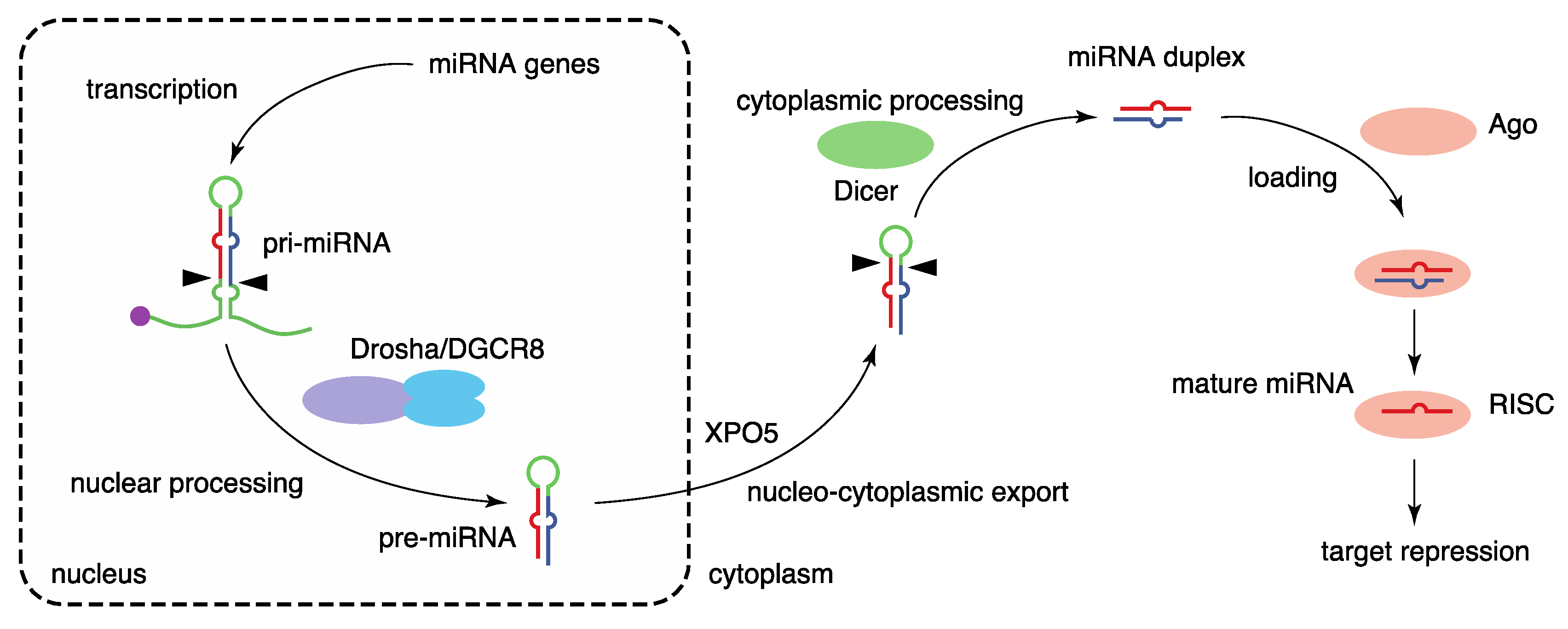Custom miRNA Synthesis Service
MicroRNAs (miRNAs) are small, non-coding RNA molecules approximately 22 nucleotides in length that play crucial roles in post-transcriptional gene regulation and various biological processes, including cell differentiation, proliferation, and apoptosis. As these molecules have emerged as promising therapeutic targets and biomarkers in drug development, Creative Biolabs offers comprehensive miRNA synthesis services to support your research and therapeutic development initiatives. Leveraging our advanced synthesis platform and extensive expertise in molecular biology, we ensure the production of high-quality synthetic miRNAs with exceptional purity and specificity, enabling pharmaceutical companies and research institutions to accelerate their development programs.
miRNA Introduction
MicroRNAs (miRNAs) are small, single-stranded non-coding RNA molecules, typically 21-23 nucleotides in length, that function as key regulators of gene expression at the post-transcriptional level. Since their initial discovery in 1993, miRNAs have been recognized as essential biological regulators in numerous cellular processes.
Biogenesis of miRNAs
The biogenesis of miRNAs follows a complex but well-orchestrated pathway that begins in the nucleus, where genes encoding miRNAs are transcribed by RNA polymerase II to generate primary miRNAs (pri-miRNAs). These pri-miRNAs are then processed by the microprocessor complex containing Drosha and DGCR8 to form precursor miRNAs (pre-miRNAs), which are exported to the cytoplasm via Exportin-5. In the cytoplasm, the pre-miRNAs are further processed by Dicer to produce mature miRNA duplexes, and finally, one strand is selectively loaded into the RNA-induced silencing complex (RISC) to function as a mature miRNA that regulates gene expression through binding to target mRNAs.
 Figure. 1 Biogenesis pathway of canonical miRNAs.1
Figure. 1 Biogenesis pathway of canonical miRNAs.1
Functions of miRNAs
The core part of miRNA genes is a hairpin that eventually will come into being a ribonucleoprotein complex, which knocks down target genes' expression through the identification and destruction of its transcript. Structural elements of this hairpin present a signal for processing by DROSHA and DICER, resulting in the formation of an approximately 20-23 bp miRNA duplex. The functional sequence of mature miRNA duplex is incorporated into the RNA-induced silencing complex (RISC), which promotes target mRNA recognition and ultimately cause gene knockdown. Synthetic miRNAs and by-products of the miRNA pathway, such as siRNAs (small interfering RNAs) and shRNAs (short hairpin RNAs), so far have been commonly used tools in molecular and cell biology.
Key Characteristics of miRNA
| Feature | Description | Research/Therapeutic Implication |
|---|---|---|
| Size | 21-24 nucleotides | Small size facilitates chemical synthesis and modification |
| Conservation | High sequence and structural conservation across species | Findings in model organisms often translatable to humans |
| Expression | Temporal and tissue specificity | Useful as disease-specific biomarkers and therapeutic targets |
| Stability | Resistant to degradation in biofluids (e.g., serum, saliva) | Ideal for non-invasive diagnostic tests (liquid biopsies) |
| Mechanism | Binds mRNA leading to degradation or translational repression | Enables targeted silencing of disease-driving genes |
Our Strategies for miRNA Synthesis
At Creative Biolabs, we employ cutting-edge technologies and proven methodologies to ensure the highest quality miRNA synthesis, offering comprehensive approaches to meet diverse research needs.
Chemical Synthesis Strategy
Our solid-phase synthesis platform utilizes advanced phosphoramidite chemistry to produce high-quality synthetic miRNAs with precise sequence control. This method enables various modifications including 2'-O-methyl, 2'-fluoro, and phosphorothioate linkages to enhance stability and functionality.
Enzymatic Synthesis Strategy
We offer in vitro transcription using T7 RNA polymerase for longer RNA sequences and precursor miRNAs. This approach ensures natural RNA structure and is particularly suitable for producing pre-miRNAs and other regulatory RNA molecules.
Concatenation Strategy
We leverage natural miRNA gene architecture to create concatenated formats under the control of a single promoter. This powerful approach enables simultaneous targeting of multiple genes and enhanced knockdown potency through multiple miRNAs per target.
A Flexible Suite of Services at Creative Biolabs
Creative Biolabs provides comprehensive miRNA synthesis services with flexible customization options to meet your specific research requirements. Our experienced scientific team works closely with clients throughout the entire process, from initial consultation to final delivery, ensuring high-quality results that align with your research objectives. To initiate your project and help us deliver the most suitable solutions, we have established a streamlined workflow and require specific information to optimize your miRNA synthesis.
Custom miRNA Synthesis
We employ state-of-the-art automated synthesizers for solid-phase phosphoramide chemistry, a method that ensures high coupling efficiency and sequence fidelity—crucial factors given the greater difficulty of RNA chemistry compared to DNA synthesis.
Quality Control
Each synthetic miRNA undergoes rigorous quality control including HPLC purification, mass spectrometry analysis, and PAGE verification to ensure high purity, correct sequence, and structural integrity.
Customization Options
We provide extensive modification options including fluorescent labeling, biotin conjugation, and various chemical modifications to enhance stability and cellular uptake, tailored to your specific research requirements.
Chemical Modifications
Biological environments contain high concentrations of nucleases that rapidly degrade naked RNA. To address this challenge, our custom synthesis platform offers a portfolio of stabilizing modifications.
| Modification | Purpose | Therapeutic Relevance |
|---|---|---|
| 2'-O-Methyl (2'-OMe) | Enhanced stability against nuclease degradation; reduced immunogenicity. | Widely used in early-stage preclinical studies. |
| Phosphorothioate (PS) | Increases stability by modifying the phosphate backbone; improved cell uptake. | Standard modification for in vivo applications. |
| Locked Nucleic Acids (LNA) | Provides extremely high target-binding affinity and thermal stability. | Crucial for high-potency miRNA inhibitors. |
| Fluorescent Labels (e.g., Cy3, FAM) | Enables tracking, visualization, and validation of cellular uptake and distribution. | Essential for mechanistic studies and functional validation. |
Our Collaboration Process
-
Project Evaluation
Submit your project requirements including target information, sequence design, and any specific modifications needed. Our experts will evaluate your project and provide professional suggestions.
-
Project Confirmation
After detailed discussion and assessment, we will provide a comprehensive project proposal including timeline, deliverables, and pricing for your confirmation.
-
miRNA Synthesis
Upon project initiation, our experienced team will synthesize your miRNA using the most appropriate strategy, incorporating any requested modifications or special requirements.
-
Quality Control
All synthesized miRNAs undergo comprehensive quality control testing, including HPLC purification, mass spectrometry analysis, and structural verification to ensure product quality.
-
Delivery and Documentation
Final products are delivered with complete documentation including quality control reports, certificates of analysis, and technical support for your research applications.
Customer Review

"The high quality and guaranteed low-endotoxin of Creative Biolabs' custom AntagomiRs provided confidence to proceed to our in vivo mouse model. We observed significantly less off-target immune activation than with product from our previous vendor, which has been very important for our upcoming Phase I IND."
— Dr. J. K., PI

"Our therapeutic program needed a complex, multi-modified miRNA mimic on a multi-gram scale. Creative Biolabs' technical team was outstanding. They were able to deliver the highly specified LNA- and 2'-O-methyl-modified product well before deadline with MS verification for all modification sites, which moved our IND-enabling studies forward by months."
— Ms. S. H., Lead Scientist

"We employed Creative Biolabs' custom miRNAs for a large screen to discover novel biomarkers of heart failure. Batch-to-batch consistency and high coupling efficiency were critical for the integrity of our high-throughput screen, allowing us to deposit our differential expression data into GEO with confidence in the high quality and provenance of the inputs."
— Prof. M. A., Director
Frequently Asked Questions
Q: What is the minimum order quantity for miRNA synthesis? Can I order different amounts for different sequences?
A: The minimum order quantity is generally 1 mg per sequence. We offer flexible ordering options for different sequences within the same order, with customized packaging available for high-throughput projects. Special pricing is available for bulk orders or academic projects. Each sequence can be synthesized in your specified amount with flexible aliquoting options. For preliminary studies requiring smaller amounts, please contact our technical support team to discuss solutions. We also provide quantity discounts and can accommodate rush orders with expedited delivery when needed.
Q: How should I store the synthesized miRNAs, and what is their shelf life?
A: For optimal stability, store lyophilized miRNAs at -20°C and reconstituted miRNAs at -80°C. Under these conditions, lyophilized miRNAs remain stable for up to 24 months, while reconstituted miRNAs should be used within 6 months. We recommend aliquoting reconstituted miRNAs to avoid repeated freeze-thaw cycles. Each product comes with a detailed stability report and storage guidelines. Store in original sealed containers with desiccant and follow RNase-free handling protocols. Our technical support team provides assistance with storage-related questions and stability troubleshooting.
Q: If my sequence contains modified bases or special modifications, what additional information do I need to provide?
A: For modified sequences, please provide the exact position and type of each modification (e.g., 2'-O-Me, 2'-F, PS linkages), whether modifications apply to specific bases or the entire sequence, and your intended application requirements. Our team reviews modification compatibility and synthesis feasibility, offering alternative suggestions if needed. We provide free consultation for complex modifications and detailed documentation of modification strategies. Consider stability requirements and experimental conditions when selecting modifications. Early consultation helps optimize design and ensures successful synthesis.
Q: Do you provide different synthesis scales for different applications? How do I choose the right scale for my research?
A: We offer three main synthesis scales: Research Scale (1-5 mg) for initial studies, Development Scale (5-20 mg) for optimization and preclinical work, and Large Scale (>20 mg) for therapeutic development. Scale selection depends on your experimental design, study duration, cell types, delivery methods, and required replicates. Our technical team helps calculate optimal synthesis scale based on your specific applications and provides detailed yield estimates. Custom scaling options are available for special requirements. Contact us for guidance on cost-effective solutions.
Connect with Us Anytime!
Creative Biolabs is a global leader in molecular biology services, providing custom miRNA synthesis services—a critical resource designed to provide researchers and pharmaceutical innovators with high-purity, customized oligonucleotides to accelerate breakthrough discoveries and validate new therapeutic targets. Contact us today for a quotation or any question. Our customer service representatives are available 24 hours a day!
Reference
- Matsuyama, Hironori, and Hiroshi I. Suzuki. "Systems and synthetic microRNA biology: from biogenesis to disease pathogenesis." International journal of molecular sciences 21.1 (2019): 132. https://doi.org/10.3390/ijms21010132 (Distributed under Open Access license CC BY 4.0, without modification.)
